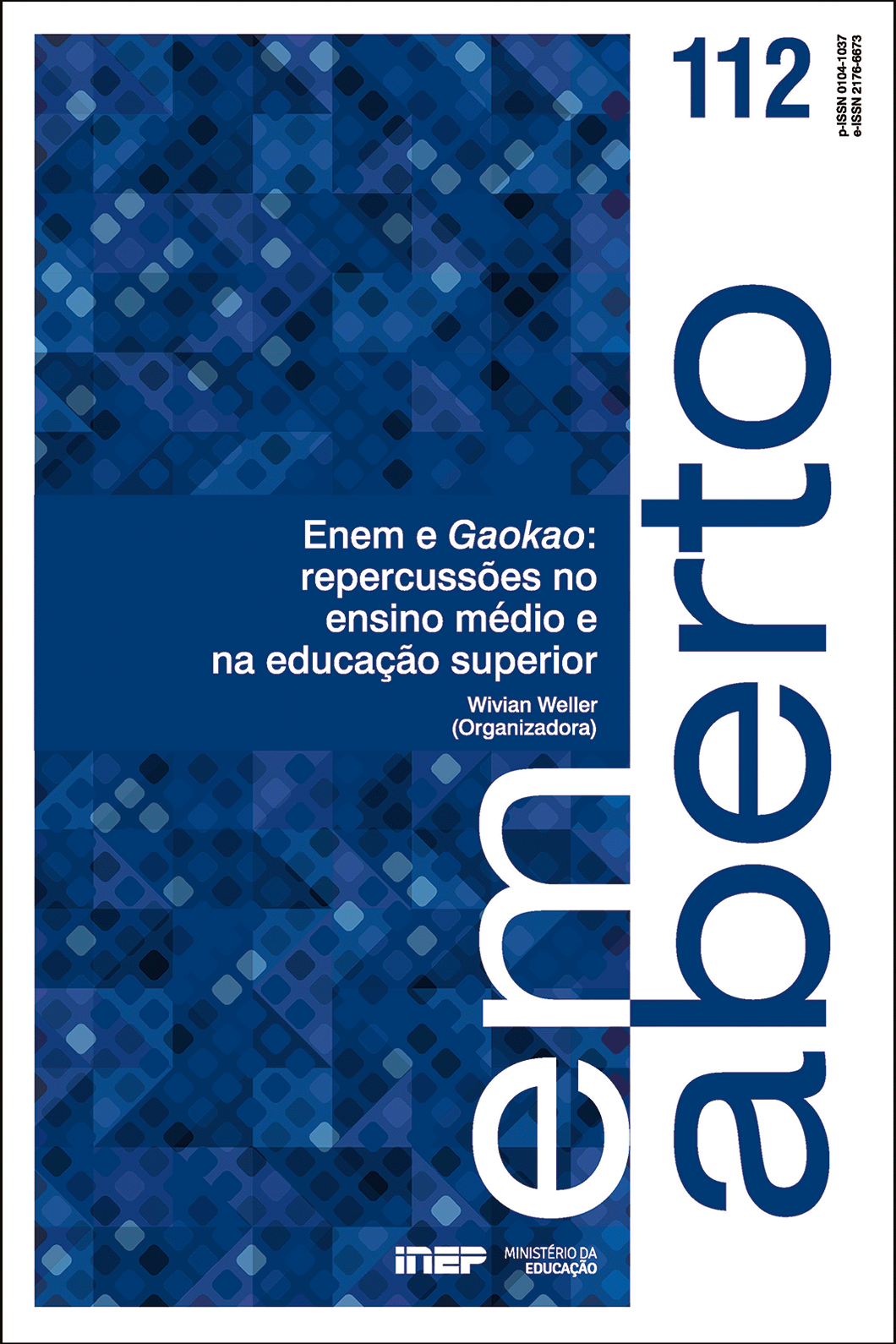Socio-economic factors associated with student performance on Enem
Abstract
Social differences have been associated with differences in performance on large-scale educational tests. Studies based on data from the National High School Exam (Enem) on this theme are rare and, at times, do not include some variables (such as school delay) and do not approach tests of the four areas of knowledge. Aiming to examine the social variables that explain the performance in the four tests of the 2018 Enem edition, school delay, gender, color/race, socioeconomic status (SES) and administrative dependence of the student’s school were analyzed. In addition to evaluating the association between the variables and performance, this study verifies whether the effects of SES varied across schools. This study also uses a modeling using multilevel linear regression. All variables were statistically significant, but their relevance varied. White students outperformed other students by less than 10.0 points, and studying at a private school was associated with an increase of up to 83.9 as compared to studying at a state school. SES’s effect on performance varied across schools. Our findings point to a persistent educational inequality in Enem.
Downloads
References
ALVES, M. T. G.; FERRÃO, M. E. Uma década da Prova Brasil: evolução do desempenho e da aprovação. Estudos em Avaliação Educacional, São Paulo, v. 30, n. 75, p. 688-720, jan. 2020.
ALVES, M. T. G.; SOARES, J. F.; XAVIER, F. P. Desigualdades educacionais no ensino fundamental de 2005 a 2013: hiato entre grupos sociais. Revista Brasileira de Sociologia, Porto Alegre, v. 4, n. 7, p. 49-81, jan./jun. 2016.
ANDRADE, J. M.; LAROS, J. A. Fatores associados ao desempenho escolar: estudo multinível com dados do SAEB/2001. Psicologia: Teoria e Pesquisa, Brasília, DF, v. 23, n. 1, p. 33-41, mar. 2007.
ARISTIZABAL, G. C.; CAICEDO, M. C.; PARRA, J. C. M. Factores asociados a la adquisición de competencias en América Latina. Revista de Ciencias Sociales, Maracaibo, Venezuela, v. 23, n. 4, p. 33-52, oct./dic. 2017.
BARBETTA, P. A.; ANDRADE, D. F.; TAVARE.S, H. R. Estudo de fatores associados através de regressão quantílica hierárquica. Estudos em Avaliação Educacional, São Paulo, v. 29, n. 71, p. 320-349, 31 ago. 2018
BATES, D. et al. Fitting linear mixed-effects models using lme4. Journal of Statistical Software, Innsbruck, Austria, v. 67, n. 1, p. 1-48, 2015.
BONAMINO, A. et al. Os efeitos das diferentes formas de capital no desempenho escolar: um estudo à luz de Bourdieu e de Coleman. Revista Brasileira de Educação, Rio de Janeiro, v. 15, n. 45, p. 487-499, dez. 2010.
BRASIL. Lei nº 9.394, de 20 de dezembro de 1996. Estabelece as diretrizes e bases da educação nacional. Diário Oficial da União, Brasília, DF, 23 dez. 1996. Seção 1, p. 27834-27841.
BRASIL. Lei nº 12.711, de 29 de agosto de 2012. Dispõe sobre o ingresso nas universidades federais e nas instituições federais de ensino técnico de nível médio e dá outras providências. Diário Oficial da União, Brasília, DF, 30 ago. 2012. Seção 1, p. 1-2.
BRASIL. Instituto Nacional de Estudos e Pesquisas Educacionais Anísio Teixeira (Inep). Microdados do Enem 2018. Brasília, DF, 2018. Available in: <https://www.gov.br/inep/pt-br/acesso-a-informacao/dados-abertos/microdados/enem>. Acess in: 23 mar. 2021.
BROER, M.; BAI, Y.; FONSECA, F. Socioeconomic inequality and educational outcomes: evidence from twenty years of TIMSS. Cham: Springer International Publishing, 2019. v. 5 Available in: <http://link.springer.com/10.1007/978-3-030-11991-1>. Acess in: 23 mar. 2021.
CHALMERS, R. P. MIRT: a multidimensional item response theory package for the R environment. Journal of Statistical Software, Innsbruck, Austria, v. 48, n. 6, p. 1-29, 2012.
COWAN, C. D. et al. Improving the measurement of socioeconomic status for the national assessment of educational progress: a theoretical foundation. [S.l]: [s.n.], 2012. Available in: <https://nces.ed.gov/nationsreportcard/pdf/researchcenter/Socioeconomic_Factors.pdf>. Acess in: 24 mar. 2021.
GIGNAC, G. E.; SZODORAI, E. T. Effect size guidelines for individual differences researchers. Personality and Individual Differences, v. 102, p. 74-78, Nov. 2016.
GOMES, C. M. A.; AMANTES, A.; JELIHOVSCHI, E. G. Applying the regression tree method to predict students’ science achievement. Trends in Psychology, v. 28, n. 1, p. 99-117, mar. 2020.
KARINO, C. A.; LAROS, J. A. Estudos brasileiros sobre eficácia escolar: uma revisão de literatura. Revista Examen, Brasília, v. 1, n. 1, p. 95-126, 2017.
LAROS, J. A.; MARCIANO, J. L.; ANDRADE, J. M. Fatores associados ao desempenho escolar em Português: um estudo multinível por regiões. Ensaio: avaliação e políticas públicas em educação, Rio de Janeiro, v. 20, n. 77, p. 623- 646, dez. 2012.
R CORE TEAM. R: a language and environment for statistical computing. Vienna, Austria: R Foundation for Statistical Computing, 2019. Available in: <https://www.R-project.org/>. Access in: 25 Oct. 2019.
SAMEJIMA, F. Estimation of latent ability using a response pattern of graded scores. Psychometric Monograph, n. 17, 1969. Available in: <https://www.psychometricsociety.org/sites/default/files/pdf/MN17.pdf>. Acess in: 15 ago. 2018.
SENKEVICS, A. S.; MELLO, U. M. O perfil discente das universidades federais mudou pós-lei de cotas? Cadernos de Pesquisa, São Paulo, v. 49, n. 172, p. 184- 208, abr./jun. 2019.
SIRIN, S. R. Socioeconomic status and academic achievement: a meta-analytic review of research. Review of Educational Research, v. 75, n. 3, p. 417-453, Sept. 2005.
TRAVITZKI, R.; FERRÃO, M. E.; COUTO, A. P. Desigualdades educacionais e socioeconómicas na população brasileira pré-universitária: uma visão a partir da análise de dados do Enem. Arquivos Analíticos de Políticas Educativas, Arizona, USA, v. 24, n. 74, p. 1-32, jul. 2016.
VALENTINI, F. et al. Análise de regressão multinível: exemplo prático. In: SILVA, M. C. R. da et al. (Org.). Aplicações de métodos estatísticos avançados aplicados à avaliação psicológica e educacional. São Paulo: Vetor, 2015. p. 135-152.
VIEIRA, I. S. Oportunidades educacionais no Brasil: o que dizem os dados do Saeb. Estudos em Avaliação Educacional, São Paulo, v. 30, n. 75, p. 748, jan. 2020.
ZWICK, R.; YE, L.; ISHAM, S. Using constrained optimization to increase the representation of students from low-income neighborhoods. Applied Measurement in Education, v. 32, n. 4, p. 281-297, Sept. 2019.
Copyright (c) 2021 Em Aberto

This work is licensed under a Creative Commons Attribution-NonCommercial 4.0 International License.
These are the terms of this Copyright Notice:
- I declare that I permanently forfeit in favor of the National Institute of Educational Studies and Research (INEP) all rights related to:
-
- editing, publication, reproduction, and distribution of the work;
- publication through digital and electronic media;
- translation of the work to any language;
- updating, re-printing, adaptation, and compression of the work;
- uploading of work in the publishing platform of INEP;
- divulging complete or parts of work through the World Wide Web (internet), whether in Brazil or foreign countries;
- authorization of third parties to execute any of the acts mentioned before.
- I explicitly declare that I am solely responsible for the opinions expressed in the work, and its publication does not violate the rights of third parties.
- I declare that the nature of said work is one of pro bono publico and, as such, I forfeit the right to any compensation regarding ownership rights granted.
- I authorize spelling and grammatical review of the manuscript, provided that the content and opinions therein remain unchanged.












